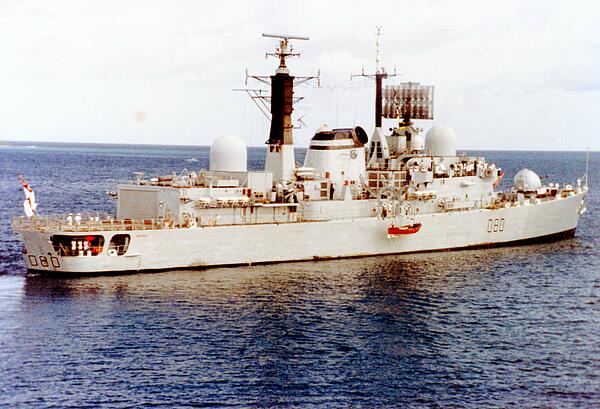HMS Sheffield
Described as the first major casualty of the British during the 1982 Falklands War, HMS Sheffield was a Type 42 guided missile destroyer. She was lost as a result of a well-aimed Exocet missile fired by the Argentines during the conflict.
The guided missile destroyer HMS Sheffield was the first major loss suffered by the British Task Force during the 1982 Falklands War. First launched in June of 1971, the ship was then commissioned for service in February of 1975. HMS Sheffield was hoped to offer the naval fleet of ships with a strong defence to ward off any air attacks from the enemy during the conflict. Each of the ships in the Type 42 destroyer vein was equipped with Sea Dart surface-to-air missile systems as well as an anti-submarine helicopter, rendering them a strong form of defence against possible assaults.
The ship offered protection for the big vessels including Invincible and the Hermes as they first approached the waters around the Falkland Islands. The British Task Force simply could not afford to lose these ships and so it was essential that HMS Sheffield and others in her vein did their duty as they were effectively the first line of defence.

HMS Sheffield took over the watch post from HMS Coventry on 4 May, 1982 and troops received the ‘Sheffield is hit’ message via the Coventry. HMS Sheffield’s Lynx helicopter landed on HMS Hermes and information was then gleaned about what had happened. On board the Lynx was HMS Sheffield’s Operations Officer and Air Operations Officer, both of whom confirmed that the ship had indeed been hit by a missile.
While HMS Sheffield was fitted with a Type 965 radar system, it was not the very latest system and while it was able to detect high-flying planes and missiles, it did not manage to detect the Exocet missile that that had been fired from a Super Étendard built in France.
The missile had been launched by the pilot,Captain Augusto Bedacarratz, when he was just six miles from HMS Sheffield, meaning that it flew just above sea level and it was too close for the detection system on the ship to pick it up. The crew on board the HMS Sheffield would have only had a mere five seconds warning that a missile was about to hit, meaning that it was far too late for anything to be done to prevent it.
The Exocet missile hit the ship eight feet above the water line, making an enormous hole in the ship and running its electricity generating systems. This meant that the ship could no longer make use of its anti-fire mechanisms, therefore removing a major part of its defence. The ship was evacuated, with those who had suffered serious burns being removed from the vessel first. The ship was towed away from the Task Force in a bid to prevent the other ships that were helping the HMS Sheffield from being targeted by the enemy from the air. It was during this removal that the weather became increasingly inclement and water began leaching into the damaged hull of the ship. A swift decision to deliberate sink the ship by allowing water to flow into the hull, was made. Overall, 20 men had been killed during the attack on HMS Sheffield, a stark reminder of the vulnerability of the British fleet. Today, as a result of the importance of the attack and the part the ship played in the Falklands conflict, HMS Sheffield is a recognised war grave.
See also: HMS Ardent
MLA Citation/Reference
"HMS Sheffield". HistoryLearning.com. 2025. Web.
